
Imagine living in your customer’s house. You dig into their wardrobe. You raid their fridge. You may even sleep on their beds.
And you do it all with their permission—of course! What you’ll observe as an ethnographic market researcher there could ignite your next big business idea.
Welcome to the world of Small Data.
Written by one of my favourite authors Martin Lindstrom (read my review of three of his previous books—Brand Sense, Buyology, and Brandwashed), Small Data: The Tiny Clues That Uncover Huge Trends demonstrates how the self-proclaimed “modern-day Sherlock Holmes” unearths hidden nuggets of market wisdom by eating, living and breathing in his client’s potential customers’ homes.
By spending close to 300 nights a year in stranger’s homes, he could craft customer narratives by juxtaposing broad socio-cultural and psychological trends with the smallest little actions (or inactions) in the lives of consumers.
This is then used by major brands around the world to launch new products or remodel their businesses.
Before we venture into the techniques used to mine small data, however, let us first talk about the elephant in the room—Big Data.
The Limitations of Big Data
Everybody is talking about Big Data and its close cousin Data Analytics. There are entire university courses on big data.
However, there are limitations to what big data can do, as elegantly described by Chip Heath in the book:
- Big Data doesn’t spark insight: Most business ideas come from the melding of intuition and insight gleaned from experience.
- Big Data favour analysis over emotion: Can analytics capture emotions like beautiful, awesome, irresistible, sexy or aegyo? Nope it can’t.
Besides the above, Big Data is also backward rather than forward looking. You can tell from your Google Analytics data where people came from, how long they spent on your website, and which pages they like, but you can’t use that to formulate a new business unit or product line.
What is Small Data Research?
Enter Small Data. Or more specifically, small data research, which can be defined as follows:
Small Data is “the process of digging through small pieces of data to build a case or a hypothesis. These are often blended with other insights and observations gathered from around the world to create a solution that forms the foundation of a future brand or business.”
Small data could be “inside an oven or a medicine cabinet or a Facebook photo album. It could be contained in a toothbrush holder in a bathroom or how a family’s shoe collection is arrayed in a hallway.”
The goal is to uncover “unmet or unacknowledged desire that forms the foundation of a new brand, product innovation, or business.”
A part of the research process involves what Lindstrom termed SubText Research (or Subtexting). This is a detailed process involving visiting consumers in their homes or at work, gathering small data offline and online and crunching (or small mining) these clues with observations and insights taken from around the world.
By looking for smallish (and even inane) topics, symbols, actions and behaviours on the ground, Lindstrom seeks to build a footbridge with the audiences that he studies. Such techniques are part of the broader umbrella of ethnographic research—a qualitative market research technique popularised by companies such as P&G where researchers observe and/or interact with a study’s participants in their real-life environment.
The 7 Cs Small Data Research Framework
To benefit from small data research, consider adopting the 7Cs Framework used by Martin Lindstrom as part of his globe-trotting research:
- Collecting
- Clues
- Connecting
- Causation
- Correlation
- Compensation
- Concept
#1 Collecting—How Observations are Translated in a Home
Begin by cutting yourself off from the familiar. Become a stranger, and discard your preconceived notions.
Talk to cultural observers who could be expats or people (like taxi drivers and hairdressers) who see a community through objective eyes.
Ask questions such as these:
- What does the neighbourhood, city or town look and feel like?
- Are the sidewalks deserted or full of life?
- Are the children playing?
- Are people friendly?
- Do you sense any neighbourhood pride?
- Are people scared?
- What makes a city or town come together?
From your initial observations, try to create a hypothesis before entering a consumer’s home. Capture as many different perspectives from as many trustworthy sources as possible.
Do also interview your brand’s past, current and potential future users.
#2 Clues—Focus on Distinctive Emotional Reflections
Once you have your initial narrative/hypothesis in mind, see if you can develop a cohesive story based on the evidence which you see.
Are the voices of the little things in a home congruent? Or are they out of tune?
Is there an unconscious seemingly random piece of small data like a refrigerator magnet or a set of kitchen utensils that stand out?
Everything in the home—from the art on the walls to the bedsheets in the master bedroom—should be analysed and studied.
Do also look at what is missing in the picture, as these can yield significant insight.
Useful practices include asking respondents to show you their old photo albums, the contents of their fridge or kitchen cabinets, and looking at what they download on their smartphones. What movies do they watch? What games do they play?
#3 Connecting—Giving Direction To Your Small Data
Next, consider how the different pieces of small data can fit together.
Are there any similarities among the clues which you have amassed? Do they seem to point in one direction? Can they help you to validate your hypothesis?
Look for an exaggeration which unveils an emotional gap—too much or too little of something. Examine the body language of your participants to see if there is any unease or outright discomfort.
#4 Causation—Uncover the Emotions Evoked
Here, see if you can begin the process of Small Mining to unearth the root causes of what you’ve observed.
You can consider adopting what Lindstrom does which is to mount all the photographs on a huge bulletin board.
See if you can find any correlations. Seek out commonalities.
Ask yourself what emotions will these “social objects” evoke in a human being. How would a person feel? What unmet desires do they represent?
Do also test your observations with cultural or local observers whom you interviewed prior to the clue-gathering process.
#5 Correlation—Examining the Entry Points of Behaviours or Emotions
At this stage, your goal is to find evidence of a shift or change in the consumer’s behaviour (aka an entry point).
Ask the following questions:
- When did the change take place?
- Was there a transitional event, eg getting married, having her first child, getting divorced, first day at work?
Often, an entry point can be expressed by changes in clothing or new friends. They often happen during a major milestone or career transition.
Once again, it is useful to validate these entry points with cultural observers. You can also test them with your respondent’s family or friends.
#6 Compensation—Finding Unmet or Unfulfilled Desire
After detecting the shift in your protagonist, your next job is to “distill it to its most emotional essence: desire.”
To do so, ask yourself if there is a desire that is not being fulfilled in your consumer’s life. What is the best way to fulfill it?
Consider poring through people’s photo albums to find their happiest moments. Use them as reflections of a time, or a moment, when they felt most in harmony.
Make sure that the desire which you’ve identified can complement both cultural and local observations.
#7 Concept—Creating the “Big Idea” for the Consumer Desire
Here is where it all comes together. From your observations, find a way to merge them into a refreshing concept that meets that unmet desire.
Stating that “ideas are less likely to germinate under pressure,” Lindstrom suggests that you swim, bike, walk along the sand, or perhaps take a shower! Doing so could help you to mix and match that concept to meet their latent consumer need.
Examples of Small Data in Action
In the example of LEGO Mindstorms—the company’s brand of customisable robots—it involved merging LEGO building blocks with a computer chip.
The idea behind LEGO Mindstorms came about when an ethnographic visit by LEGO marketers to an 11-year-old boy in Germany revealed how proud he was in an old pair of Adidas. Apparently, the boy was proud of how one side of the sneakers was down and abraded at exactly the right angle. The entire look of the sneakers signaled that he was one of the best skateboarders in the city.
This sparked the insight that kids wanted something challenging and tangible. For LEGO users, the brand was all about “the summons, the provocation, the mastery, the craftsmanship and, not least, the hard-won experience.”
Similarly, a visit to the rooms of teenage girls sparked the insight for Tally Weijl 2.0 (a European fashion brand focused on young adults and teens) to mix and match social media with a traditional dressing room.
The decor of the boutiques melded childhood icons like teddy bears and dolls, with more adult tastes like a catwalk, spa and music studio.
Conclusion
Small Data provides an interesting insight to the work of ethnographic researchers like Martin Lindstrom.
By mixing everyday observations with broader societal, economic and cultural trends, Subtexting and Small Mining can help to inform the product development strategies of companies in a more targeted fashion.
I highly recommend you to pick up the book to find out how Lindstrom himself uses this technique to come up with new creative ideas.
While the 7Cs framework may provide a broad structure for this exercise, I suspect that the process of unearthing these gems is probably more intuitive and accidental than planned.


Fine way of telling, and pleasant post. Nice info! Thanks a lot for sharing it, that’s truly has added a lot to our knowledge about this topic. Have a more successful day. Amazing write-up, always find something interesting.
Thanks